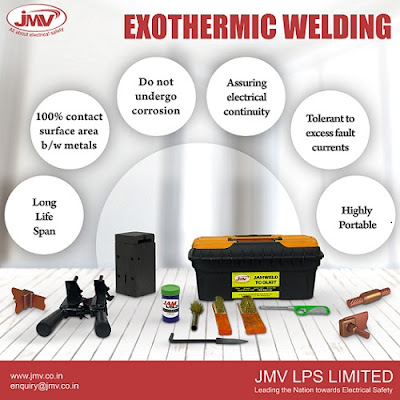Exothermic Welding – It works well and stays for long
One of the major sections in electrical earthing installation is jointing. In every electrical installation, there is a demand for connecting dissimilar conductors. Perhaps there are many different ways for you to go about it. You need to choose the best method and the best tool to establish proper connection which stays for long.
The millions of jointing approaches do not ensure perfectly finished joints stayed together forever. Conventionally, earthing or lightning conductors were joined using brazing, bolting, crimping, compression etc. But these methods yield loose and lower quality joints. They tend to get corroded and get disconnected within some years of installation.
The electrical/ electronic equipments or exposed parts of the installation must be linked to earth for conduction of electrical faults to the ground. These energized events always look for a low resistant flow for its easy flow to the ground. It can make its own way through any conducting equipment or even a human body. To safeguard the people and property, an intended low resistant path. We can understand the importance of earthing and bonding system. But for it to be proper and long lasting, certain aspects associated with the technique practiced traditionally must be reconsidered. The connections established are responsible for uninterrupted flow of current throughout the electrical installation/ circuitry. Hence, conventional methods must be avoided as they make porous, weak and uneven joint.
Exothermic welding system is the most advanced and the reliable connecting technology till date. Exothermic weld joints are joints with 100% contact surface. It can be used to create – Tee joint, Cross joint, H joint, parallel joint, straight joint, etc. This highly recommended technology makes use of a graphite mould, weld powder, mould holding clamp, cleaning brush and a flint gun. This technique is easy and is suitable for jointing any materials. A graphite mould is used which is made according to the dimensions of the conductors and the type of joint that is to be made. Before making joints, the surface of the conductors and the mould is cleaned with cleaning brush so that no impurities or moisture stays on them which can lead to low quality joints. After cleaning, the conductors are placed inside the mould. Then, the weld powder is poured into the mould after closing the mould. The weld powder is ignited using flint gun which will initiate chemical reaction inside the mould. The reaction melts the weld powder which on cooling will produce exothermically welded connection.
The millions of jointing approaches do not ensure perfectly finished joints stayed together forever. Conventionally, earthing or lightning conductors were joined using brazing, bolting, crimping, compression etc. But these methods yield loose and lower quality joints. They tend to get corroded and get disconnected within some years of installation.
The electrical/ electronic equipments or exposed parts of the installation must be linked to earth for conduction of electrical faults to the ground. These energized events always look for a low resistant flow for its easy flow to the ground. It can make its own way through any conducting equipment or even a human body. To safeguard the people and property, an intended low resistant path. We can understand the importance of earthing and bonding system. But for it to be proper and long lasting, certain aspects associated with the technique practiced traditionally must be reconsidered. The connections established are responsible for uninterrupted flow of current throughout the electrical installation/ circuitry. Hence, conventional methods must be avoided as they make porous, weak and uneven joint.
Exothermic welding system is the most advanced and the reliable connecting technology till date. Exothermic weld joints are joints with 100% contact surface. It can be used to create – Tee joint, Cross joint, H joint, parallel joint, straight joint, etc. This highly recommended technology makes use of a graphite mould, weld powder, mould holding clamp, cleaning brush and a flint gun. This technique is easy and is suitable for jointing any materials. A graphite mould is used which is made according to the dimensions of the conductors and the type of joint that is to be made. Before making joints, the surface of the conductors and the mould is cleaned with cleaning brush so that no impurities or moisture stays on them which can lead to low quality joints. After cleaning, the conductors are placed inside the mould. Then, the weld powder is poured into the mould after closing the mould. The weld powder is ignited using flint gun which will initiate chemical reaction inside the mould. The reaction melts the weld powder which on cooling will produce exothermically welded connection.




Comments
Post a Comment